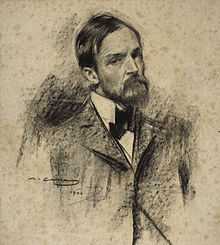Lucien Simon

Lucien J. Simon (18 July 1861–1945) was a French painter and teacher born in Paris. After graduating from the Lycée Louis-le-Grand, he studied painting at the studio of Jules Didier, then from 1880 to 1883 at l’Académie Julian.
He exhibited at the Salon des Artistes Francais from 1891, also at the Salon de la Société Nationale des Beaux-Arts
In 1891 he married Jeanne Dauchez,[1] the sister of André Dauchez (1870–1948) and became infatuated with the scenery and peasant life of her native Brittany.
In 1895 he met Charles Cottet and became a member of his "Bande noire" or "Nubians", along with Dauchez, Xavier Prinet (1861–1946), Edmond Aman-Jean (1858–1936) and René Ménard (1862–1930), employing the principles of Impressionism but in darker tones.[2]
He was one of the founding teachers at Martha Stettler's Académie de la Grande Chaumière in 1902. He also taught at the Académie Colarossi around the same time, as well as taking private students.
He taught at École Nationale des Beaux-Arts from 1923 and elected to its Académie des Beaux-Arts in 1929, a position he held for 13 years.[3]
In 1937 he won First Prize at "l’Exposition universelle de Paris" for his work on the Luxembourg pavilion.
Paul Simon (1892–1979), the son of Lucien and Jeanne (who was also a painter), was a noted animal sculptor.[4]
A famous portrait of Simon, painted by Charles Cottet in 1907, hangs in the Musée d'Orsay in Paris.[5]
Notable Students
|
Loukia Nicolaidou
|
|
References
- ↑ http://www.porkopolis.org/art-museum/artist-index/lucien-simon/
- ↑ 2.0 2.1 2.2 http://adventuresintheprinttrade.blogspot.com/2009_09_01_archive.html
- ↑ http://historic-marine-france.com/huile/simon.htm
- ↑ http://www.paulsimon.fr/biographie_GB/biographie_gb.html
- ↑ http://www.artchive.com/web_gallery/C/Charles-Cottet/Portrait-of-Lucien-Simon-(1864-1945)-1907.html
- ↑ http://www.daao.org.au/main/read/1548
- ↑ Boas, Nancy Society of Six ISBN 978-0-520-21055-4
- ↑ http://www.evabreuerartdealer.com.au/cv/Davidson_Bessie_CV_0703.htm
- ↑ http://findarticles.com/p/articles/mi_qa4113/is_200607/ai_n17177456/
- ↑ http://abitofhistory.net/html/rhw/g_body.htm
- ↑ http://www.roberthumblot.com/SITE/bio.html
- ↑ http://serdar-hizli-art.com/modern_painting/jannot_henri.htm
- ↑ http://www.srnafinearts.at/index2.php?site=image&id=203
- ↑ http://www.snl.no/.nbl_biografi/Lul_Krag/utdypning
- ↑ http://www.onb.ac.at/ariadne/vfb/bt_fk_malschulen.htm
- ↑ http://www.safran-arts.com/42day/art/art4jan/art0109.html
- ↑ http://cwahi.concordia.ca/sources/artists/displayArtist.php?ID_artist=159
- ↑ http://www.redwoodlibrary.org/tower/frame11.htm
- ↑ http://www.ecb.int/events/pdf/art/Ireland.pdf
- ↑ http://catalogue.nla.gov.au/Record/752193
- ↑ http://www.askart.com/askart/w/john_h_weygandt/john_h_weygandt.aspx
|